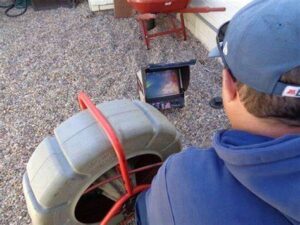▷ Safety Measures for Effective Sewer Camera Inspections In San Diego
Safety Measures for Effective Sewer Camera Inspections In San Diego
Get ready to enhance your sewer maintenance game with these 5 expert tips for conducting a seamless sewer camera video inspection. Uncover hidden issues, prevent costly repairs, and ensure your system’s optimal performance with these actionable strategies. From understanding equipment essentials to interpreting findings accurately, this guide will equip you with the knowledge needed to ace your next inspection effortlessly.
Understanding Sewer Inspection Cameras
- Types of Cameras
Sewer inspection cameras come in various types, including push cameras and crawler cameras. Push cameras are flexible and ideal for smaller pipes, while crawler cameras are more robust and suitable for larger sewer lines.
Pros:
Push cameras: Easy to maneuver in tight spaces.
Crawler cameras: Provide high-quality footage of larger pipelines.
- Camera Features
These advanced devices are equipped with high-resolution cameras, LED lights, and pan-and-tilt capabilities. The high-resolution cameras ensure clear visuals, while LED lights illuminate dark sewer lines for better inspection.
- Operation Process
To conduct a sewer camera video inspection, the camera is inserted into the sewer line through an access point. As it travels through the pipe, it captures real-time footage that is transmitted to a monitor for analysis by the technician.
Cons:
- Limited reach in complex pipe systems.
- Potential obstructions hindering thorough inspection.
- Maintenance and Care
Regular maintenance of sewer inspection cameras is crucial to ensure their optimal performance. This includes cleaning the lenses, checking cables for wear and tear, and storing the equipment properly after each use.
- Industry Standards
The use of sewer inspection cameras is regulated by industry standards to maintain accuracy and consistency in inspections. Compliance with these standards ensures reliable results and quality service delivery.
Preparing for Video Inspection
- Camera Setup
To begin, ensure the camera is functioning correctly by checking the camera head and cables for any damage. Insert a memory card into the camera to store the recorded footage.
Position the camera at the sewer cleanout or another accessible entry point. Make sure the camera head is clean to capture clear photos and videos as it navigates through the tube.
- Technical Preparation
Connect the camera to a portable device like a laptop or tablet to view live footage. Use a push cable to guide the camera through the sewer system smoothly.
Ensure that your device has enough storage space to save the video recordings during inspection. A full SD card can interrupt the process and lead to data loss.
- Inspecting Key Areas
Focus on inspecting critical points like house traps, house-to-main line connections, and areas near the curb. Look out for any signs of damage, blockages, or tree roots intrusion along these sections.
Utilize the camera to identify any sags or bellies in the sewer line that could lead to potential issues in the future.
Conducting the Inspection Safely
- Safety Measures
When conducting a sewer camera video inspection, prioritize safety measures to ensure a smooth process. Before inserting the camera inside the sewer line, wear protective gear such as gloves and goggles.
Maintain a safe distance from the house trap during the inspection to prevent any accidents. Always have someone present above ground to assist in case of an emergency.
- Proper Equipment Usage
To conduct a successful inspection, understand the correct way to use the sewer camera. Familiarize yourself with the controls and functionalities of the camera to navigate through the sewer line effectively.
- Identifying Issues
During the inspection, pay close attention to any signs of blockages or damages within the sewer line. Look out for grease build-up, tree root intrusions, or any other obstructions that could hinder proper sewage flow.
- Methodical Approach
Adopt a methodical approach when inspecting the sewer line. Start from the house trap and systematically work your way towards the main sewer line, thoroughly examining every section for potential issues.
- Maintenance Tips
After completing the inspection, provide homeowners with valuable information on maintenance tips to keep their sewer lines in optimal condition. Advise them on proper waste disposal practices and regular inspections to prevent future problems.
Identifying Common Issues
- Blockages and Traps
Sewer camera video inspections often reveal blockages caused by various factors such as grease buildup, foreign objects, or even structural issues. These blockages can lead to traps forming in the system, causing backups and slow drainage.
- Root Intrusions
One common issue detected during sewer camera inspections is tree roots infiltrating the main line. Over the years, tree roots can grow into the pipes through small cracks, causing obstructions that impede proper flow.
- Locating Access Points
During a sewer camera inspection, it’s crucial to accurately locate access points along the pipeline. This helps in determining the exact point of an issue, facilitating targeted repairs without unnecessary excavation.
- Identifying Main Line Problems
The inspection process allows technicians to visually inspect the entire length of the sewer line, identifying any main line issues such as cracks, corrosion, or misalignments. This detailed report aids in understanding the root cause of problems within the system.
Post-Inspection Steps
- Push Rod
After completing the sewer camera video inspection, one crucial post-inspection step is to carefully clean the push rod. This ensures its longevity and optimal performance for future inspections. Proper maintenance of the push rod is essential to prevent damage and maintain clear imaging during inspections.
- End
Once the inspection is done, it is vital to inspect the condition of the camera’s end. Check for any signs of wear and tear on the end of the camera, such as cracks or debris accumulation. Cleaning and checking the end of the camera after each inspection can help prolong its lifespan and ensure accurate results in future inspections.
Completing these post-inspection steps diligently can enhance the efficiency and accuracy of your sewer camera video inspections. Regular maintenance not only extends the lifespan of equipment but also ensures reliable results during each inspection session.
FAQs
Is Sewer Camera Video Inspection A Reliable Method For Assessing Sewer Conditions?
Sewer camera video inspection is highly reliable as it provides visual evidence of the sewer condition, allowing for accurate assessment of issues such as blockages, cracks, and tree root intrusions. This method helps in identifying problems quickly and planning effective solutions.
How Should One Prepare For A Sewer Camera Video Inspection?
Before conducting a sewer camera video inspection, ensure the sewer line is accessible and clear of any obstructions. It’s crucial to inform all parties involved about the inspection, secure necessary permits if needed, and schedule the inspection at a convenient time for all stakeholders.
What Are The Safety Precautions To Consider During A Sewer Camera Video Inspection?
During a sewer camera video inspection, safety precautions include wearing appropriate protective gear like gloves and goggles, ensuring proper ventilation in confined spaces, securing the area to prevent accidents, and following established safety protocols to minimize risks associated with working around sewage systems.
What Are Some Common Issues That Can Be Identified Through Sewer Camera Video Inspections?
Common issues detected during sewer camera video inspections include blockages caused by debris or grease buildup, cracks or fractures in the pipes, intrusion of tree roots into the sewer line, joint misalignments, bellied pipes (sagging), and corrosion due to age or material deterioration.
What Steps Should Be Taken After Completing A Sewer Camera Video Inspection?
After conducting a sewer camera video inspection, it is essential to review the footage with the client or relevant parties to discuss findings and recommendations. Provide a detailed report outlining identified issues, proposed solutions, cost estimates, and maintenance suggestions to ensure informed decision-making and prompt action.
Conclusion
You’ve now grasped the essentials of conducting sewer camera video inspections. By understanding the equipment, preparing meticulously, ensuring safety, identifying issues, and following up post-inspection, you’re equipped to handle this task efficiently. Remember, safety is paramount throughout the process. Regular inspections can prevent costly repairs and maintain your sewer system’s functionality. Stay proactive to catch issues early and maintain a healthy plumbing system.
Take these tips and put them into action. Regularly inspect your sewer lines to avoid surprises down the line. Your diligence will pay off in the long run by saving you money and preventing potential disasters. Keep your plumbing in top shape with these simple yet effective practices.
Give Home Pro Plumbing a call right away to learn more about how our experts can help with leak detection in San Diego, CA.
Our Plumbing & Leak Detection Services
Related Posts

▷5 Benefits of Hydro Jet Plumbing: A Comprehensive Guide In San Diego
5 Benefits of Hydro Jet Plumbing: A Comprehensive Guide In San Diego Hydrojet plumbing is a…

▷Essential Tips for Installing a Heat Pump Water Heater In San Diego
Essential Tips for Installing a Heat Pump Water Heater In San Diego Did you know that…

